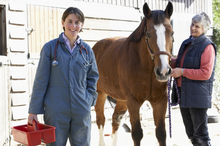Saddle Up SAFELY, a rider safety campaign sponsored by UK HealthCare, UK College of Agriculture and other organizations to reduce the number and severity of horse riding injuries, also provides information about zoonotic diseases that can be transmitted from horses to humans and how to prevent and respond to them.

Recognizing and preventing zoonotic diseases
Often the symptoms of zoonotic diseases mimic symptoms of other diseases common in humans and the only way to know if a person is affected is through a laboratory test ordered by a physician.
Although it is rare for humans to contract a disease from a horse, it is possible. Often the symptoms of zoonotic diseases mimic symptoms of other diseases common in humans and the only way to know if a person is affected is through a laboratory test ordered by a physician.
Salmonella, a disease caused by the bacteria often affects horses and is evidenced by acute or chronic diarrhea and localized infections. People are infected when they come in contact with horse manure and the symptoms include diarrhea, fever and abdominal cramping. The disease can be avoided by wearing disposable gloves and by careful washing of hands after handling manure or coming in close contact with a horse that is infected.
Salmonellosis is a disease caused by the bacteria Salmonella. Most often horses with salmonellosis have acute or chronic diarrhea, but they can also have localized infections in abscesses, joints, eyes and other areas. Wearing disposable gloves and washing hands after handling salmonellosis cases (or any animal with diarrhea) is especially important. Manure from horses with diarrhea should be composted or disposed of where humans and other horses cannot come in contact with it. Symptoms in humans include diarrhea, fever and abdominal cramping.
Ringworm is a common fungal skin infection of many animal species. In horses the problem is primarily caused by Trichophyton equinum. Horses show circular patches of hair loss with crusting and scaling of the skin. People become exposed by direct skin contact with infected horses or potentially through contact with contaminated equipment. The most common symptom is itchiness.
Anthrax is a bacterial disease that has caused sporadic animal disease outbreaks in the United States for many years. The bacterial spore can live in the soil for decades, and animals can become infected through ingestion, inhalation and other routes. Infected horses often become acutely ill and die.
People can be exposed to anthrax through contact with an infected animalâs hide, tissues or blood. Complete protective equipment â including skin, respiratory and eye protection â should be worn by veterinarians when examining a suspected anthrax case. Symptoms in people can range from blisters on the skin to vomiting blood, bloody diarrhea, stomach ache, flu-like symptoms or chest pain.
West Nile virus (WNV), eastern equine encephalitis (EEE) and western equine encephalitis (WEE) are all zoonotic diseases that can affect both humans and horses.
Mosquitoes transmit these viruses from an infected bird to a person or a horse. Infected humans and horses do not develop high enough viral levels in the blood to enable transmission of the disease to others. Therefore, these mosquito-borne diseases are zoonotic from birds to people and horses, not from horses to people.
Vaccination against EEE, WEE and WNV is very effective in reducing outbreaks of these diseases in horses.
These are a few of the zoonotic diseases that affect horses and people, Others include rabies, rain rot, and vesicular stomatitis.
Preventing the spread of zoonotic diseases
A veterinarian can develop a comprehensive program designed to help protect horses and people from infectious diseases and provide early diagnosis that can save horse owners a significant amount of money in the long run! Caretakers should use disposable gloves to handle and treat any sick horse and thoroughly wash their hands after treatments
